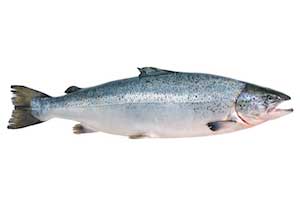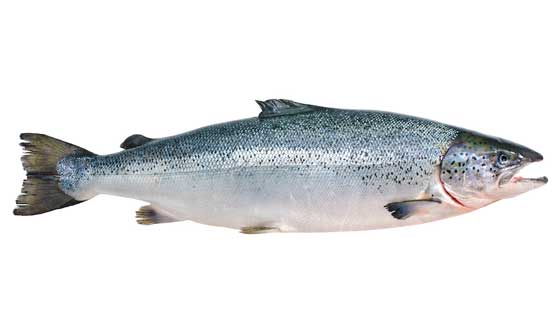Atlantic Salmon Features and Size

How to recognize an Atlantic Salmon
These are the 7 identifying features.
- They have fewer than 13 rays in the anal fin
- Their mouth is moderately large
- The shape, length of head, and depth of body vary with each stage of sexual maturity
- Their color changes with age. Small parr, older young salmon, have 8 to 11 pigmented bars or parr marks, along each side of their body alternating with a single row of red spots along the lateral line. These markings are lost when they become smolt
- Atlantic Salmon in the sea are silvery on the sides and belly, while the back varies with shades of brown, green and blue
- Atlantic Salmon also have numerous black spots, usually “X”shaped and scattered around the body
- When spawning, both sexes take on an overall bronze-purple coloration and may acquire reddish spots on the head and body
After spawning, the kelts are so dark in color that these fish are also called black salmon.
Size
Sea-run (Anadromous) Atlantic Salmon grow to a larger size than landlocked salmon. They range from 5 to 20 pounds/2 to 9 kilograms and commercially caught fish average 10 to 11 pounds/4.5 to 5 kilograms.
The world record ‘rod-caught’ Atlantic Salmon weighed 79 pounds/35.8 kilograms and was caught in Norway’s Tana River of Norway in 1891. It was 150 cm in length.
3 Diseases of Atlantic Salmon
1. Atlantic Salmon Furunculosis
A generally fatal disease that shows itself by the development of boils. The disease is bacterial and most common in the summer months when river levels are low.
2. Ulcerative Dermal Necrosis
Ulcerative Dermal Necrosis shows itself as small bleached spots on the head, back and tail. These areas are then infected by a fungus and become ulcerated.
This disease is believed to be a virus, but was never identified. While it was very common among various fish species particularly the North Atlantic Salmon and Sea Trout in the 1960s and 1970s, it’s become less prominent.
3. Infectious Salmon Anaemia
This disease has entered the press in recent years as it threatens fish farms and a multi-$100 million industry. It’s also a virus and was first discovered in 1998 in Scotland and has become endemic in Norway ever since. Recent reports had the disease showing up in western Canada, though officials claim this to be false.



